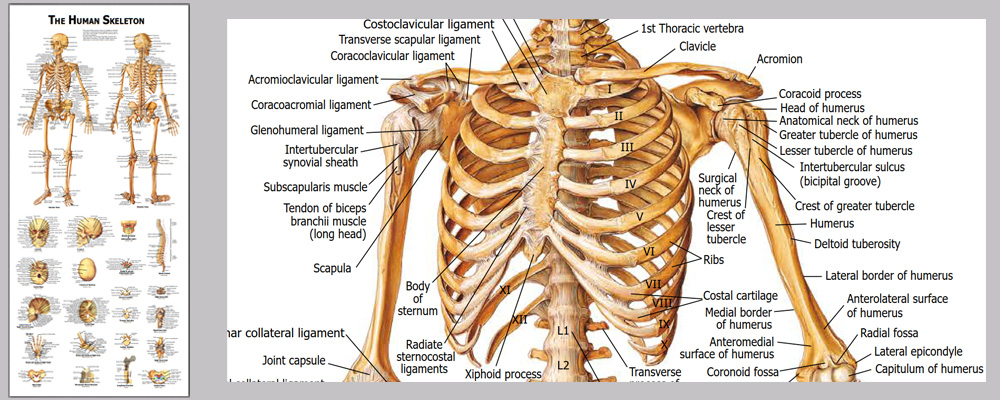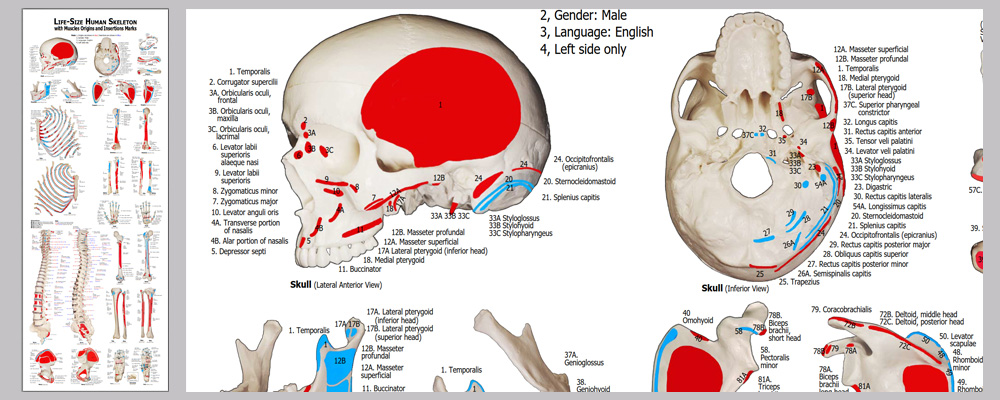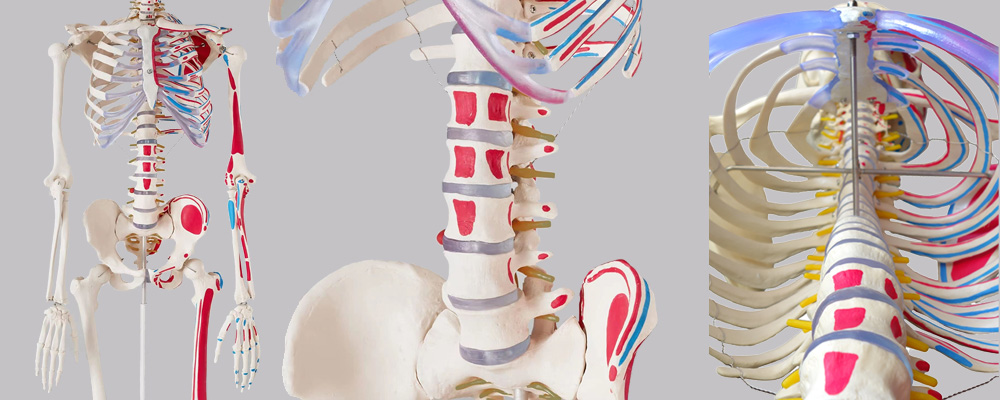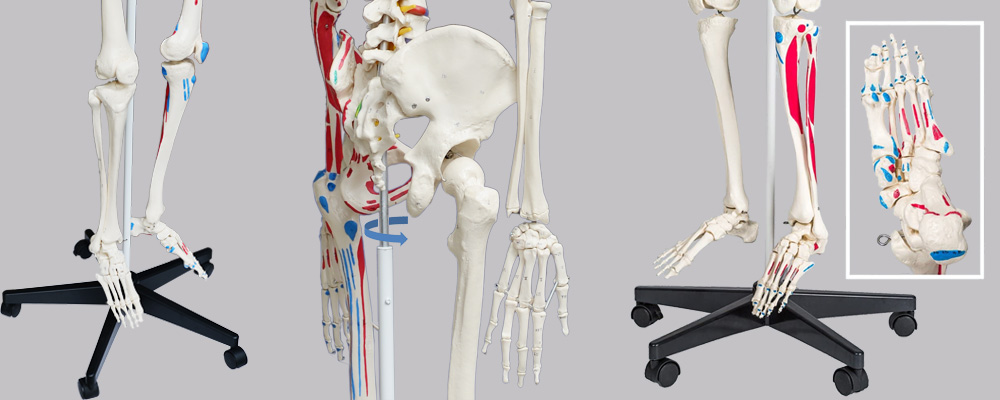human anatomical model
This life size articulated adult human skeleton model is 180cm tall & ideal for teaching / learning the basics of human anatomy. Includes a colorful Human Skeleton chart to show all the detailed structures for reference.Detailed colorful chart with over 630 accurate definitions. Durable and no reflection with matte film covered, 36 * 78cm

Detailed muscles origins and insertions with codes. Durable and no reflection with matte film covered, 100cm * 38cm

Stainless steel wires keep the ribs gaps stable.

2 of 5 casters are lockable.

With JC anatomy, you can also demonstrate the movements of the skull via the head joints, and thanks to the fully flexible spine, you can adjust the human anatomical model to place it in natural body postures. The unique combination of muscle origins and insertions, the numbered bones, flexible ligaments and flexible spine with a slipped disc between the 3rd and 4th lumbar vertebrae clearly the show medical and anatomical interest of this top model's more than 674 structures. Now available on a stable metal stand with 5 casters!
| Product name | human anatomical model |
| Place of Origin | Shenzhen China |
| Product Material | PVC, ABS, SST |
| Rib cage | A 5mm dia |
| Human skeleton model life | 18years |
| Surface treatment | Polish. Etched. Texture |
| SUPPORT 24/7 | Contact us 24 hours a day, 7 days a week |
| Size | 71 * 70 * 119 |
| Port | Shenzhen |
| PAYMENT & ORDERING | PayPal account or pay by credit card |
human anatomical model FAQs Guide Are you looking for a quick review guide about human anatomical model? An ultimate FAQs buying guide is available to help you.This guide contains all the information about all the important facts, figures, and various processes regarding human anatomical model. Let’s continue!
2.How many movable joints does human anatomical model have?
3.About human anatomical model delivery date
4.How durable is human anatomical model?
5.Why is a human anatomical model important in medical education?
6.human anatomical model Can it be used as a teaching aid?
7.human anatomical model Are accompanying labels provided indicating the name and location of each bone?
8.What are the different types of human anatomical model available?
9.human anatomical model Can it be used to show the differences in body structure between children and adults?
10.How can a human anatomical model be utilized for rehabilitation and physiotherapy purposes?
11.Is it possible to color code this human anatomical model to represent different bone parts?
12.Can this human anatomical model be used as an aid to human learning?
13.About the scale of human anatomical model factory
1.About human anatomical model production equipment
The production of a human skeleton model requires a variety of specialized equipment to ensure accuracy, durability, and detail in the final product. we around 50 sets dedicated equipment
2.How many movable joints does human anatomical model have?
There are approximately 13 movable joints in the human skeleton model, with different types of joints including ball and socket, hinge, pivot, gliding, and saddle joints. These joints allow for a wide range of movements, such as flexion, extension, rotation, abduction, and adduction.
3.About human anatomical model delivery date
Around 40 days. Depends on qty.
4.How durable is human anatomical model?
The durability of a human skeleton model can vary depending on the materials used and the quality of construction. However, generally speaking, a high-quality skeleton model can be quite durable and can last for many years if properly cared for. Here are some factors that can affect the durability of a human skeleton model: 1. Materials: The most common materials used for human skeleton models are plastic, resin, and wood. Plastic and resin models are generally more durable as they are less prone to damage from impacts or moisture. Wood models can also be quite durable, but they may be more susceptible to wear and tear over time. 2. Maintenance: Proper maintenance and care can significantly increase the durability of a human skeleton model. Regular cleaning with a soft cloth and mild detergent can help keep the model free of dust and dirt. Additionally, storing the model in a protective case or covering can also help prevent damage. Overall, a high-quality human skeleton model can be quite durable and can last for many years with proper care. However, it is important to keep in mind that no model is completely indestructible, and regular wear and tear can occur over time.
5.Why is a human anatomical model important in medical education?
Better understanding of the structure, function, and pathological changes of the skeletal system. Deeper understanding of the pathogenesis of skeletal diseases. To demonstrate and explain treatment methods for skeletal diseases
6.human anatomical model Can it be used as a teaching aid?
Yes, a human skeleton model is a commonly used teaching aid in various academic fields such as anatomy, biology, and medical education. It is an accurate and detailed representation of the human skeleton, providing a visual aid for students to understand and grasp the complexities of the skeletal system.
7.human anatomical model Are accompanying labels provided indicating the name and location of each bone?
The stardard model does not provide this function. The chart shipped with pro model shows the name and location of each bone
8.What are the different types of human anatomical model available?
1. Anatomical Skeleton Models: These models are exact replicas of the human skeletal system and are used for educational and medical purposes. They are typically made of high-quality materials such as plastic or resin and come with detailed labels for each bone, making it easy to identify and study different structures. 2. Disarticulated Skeleton Models: These models consist of individual bones that can be separated from each other. They are often used in classrooms for teaching purposes as they allow students to handle and study each bone individually, facilitating a more hands-on learning experience. 3. Flexible Skeleton Models: These models are made from a flexible material such as rubber or PVC and are designed to mimic the movements of the human body. They are often used in medical training and rehabilitation settings to demonstrate muscle and joint movements. 4. Life-size Skeleton Models: As the name suggests, these models are the same size as an actual human skeleton. They are most commonly used in medical schools and hospitals for teaching and training purposes.
9.human anatomical model Can it be used to show the differences in body structure between children and adults?
Yes, a human skeleton model can be used to clearly demonstrate the differences in body structure between children and adults. Here are some specific examples of how a skeleton model can be used to illustrate these differences: Size and proportion: One of the most evident differences between children and adults is their size and proportion. A skeleton model can be used to compare the relative sizes of different bones in a child and adult, such as the skull, spine, and limbs. Children have smaller and more delicate bones compared to adults, and their proportions also differ. For example, the head and skull of a child are proportionally larger to their body compared to an adult. In conclusion, a human skeleton model is an effective educational tool to showcase the differences in body structure between children and adults. Its three-dimensional design and ability to highlight specific bone structures make it an excellent visual aid to help understand the changes that occur during growth and development.
10.How can a human anatomical model be utilized for rehabilitation and physiotherapy purposes?
Demonstrate the right bone parts postion relationships can help doctors and patients to understanhuman skeleton model can be a valuable tool for rehabilitation and physiotherapy purposes as it can aid in teaching and demonstrating proper body mechanics, identifying and addressing musculoskeletal imbalances and dysfunctions, and monitoring progress in treatment. Here are some ways in which a human skeleton model can be utilized for rehabilitation and physiotherapy purposes: 1. Education: A human skeleton model can be used to educate patients and clients about the structure and function of the human body. This can help them understand their injuries or conditions better, and also make them more aware of how their body moves and functions. 2. Creating personalized treatment plans: With the help of a skeleton model, therapists can design personalized treatment plans for each individual patient. This can include exercises and movements targeted at specific areas of the body that need strengthening or stretching.d the right way of rehabilitation and physiotherapy.
11.Is it possible to color code this human anatomical model to represent different bone parts?
Yes, it is possible to color code a human skeleton model to represent different bone parts. This can be done through the use of different colored paints, markers, or even colored stickers. The specific colors used will depend on the preferences of the person creating the model and the level of detail they wish to include.
12.Can this human anatomical model be used as an aid to human learning?
Yes, this Human skeleton model can be used as an aid to human learning in various ways. It is a representation of the human skeleton, which is the framework of bones that supports the body and protects internal organs. This model can be used as a hands-on learning tool in classrooms, medical schools, and other educational settings. Firstly, it can be used to help students understand the structure and functions of the human skeleton. By examining the bones and their placement, students can learn about the different types of bones, such as long bones, flat bones, and irregular bones, and how they work together to facilitate movement and support the body. This model also allows students to visualize the various joints, their types and movements, and how they are connected to each other. Overall, this Human skeleton model can be a valuable tool in human learning as it provides a tangible and visual representation of the skeletal system. It allows for interactive and hands-on learning, making it easier for students to grasp complex concepts. With its versatility and usefulness in different disciplines, it can serve as an effective aid in enhancing human learning.
13.About the scale of human anatomical model factory
Covering an area of about 2000 m². This would include manufacturing space for assembly, molding, and finishing processes, as well as storage space for raw materials and finished products.




